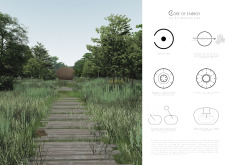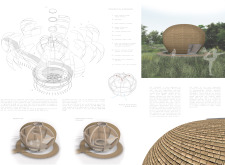5 key facts about this project
The Tiny Kiwi Meditation Cabin is a carefully designed space located in a clearing within the local New Zealand bush. It functions as a retreat for meditation and reflection, focusing on a strong connection between its users and the surrounding landscape. The design is centered around a circular shape that pulls energy from the environment and directs it inward, fostering a peaceful atmosphere for mindfulness practices.
Circular Form and Energy Flow
The circular design of the cabin plays a key role in its overall impact. It gathers energy from nature and channels it toward the interior, promoting a feeling of unity and togetherness among those who use the space. The layout includes a carefully planned viewing axis that aligns with the trees outside, enhancing visual connections to the natural setting and encouraging users to engage with their surroundings.
Light and Spatial Experience
Natural light occupies an important place in the cabin's design. Openings in the structure allow sunlight to stream in, creating engaging patterns of light and shadow throughout the day. A large skylight serves as a focal point, bringing the night sky into the cabin. This feature reinforces the sense of calm and reflection, allowing occupants to feel a connection to both the earth and the cosmos during their meditation.
Materiality and Sustainability
The cabin’s construction emphasizes local materials, aligning with a commitment to sustainability. Cedar wood shingles are used for their durability and ability to blend with the environment. Timber frames and interior cladding echo the natural surroundings, enhancing the cabin’s integration into its location. A concrete foundation provides necessary stability while adapting to the unique characteristics of the land.
Functional Elements and Interior Arrangement
Flexibility is essential in the cabin's interior, catering to a variety of activities related to meditation and mindfulness. A movable altar for processing herbs is a practical element, inviting users to interact meaningfully with their environment. The interior design encourages informal gathering arrangements, enabling participants to create circles during meditation sessions. This setup supports social interaction while still honoring individual moments of reflection.
The entrance features a sliding wooden door that complements the overall look of the cabin. It offers easy access and reflects traditional design influences, connecting the structure to its natural surroundings.






















































